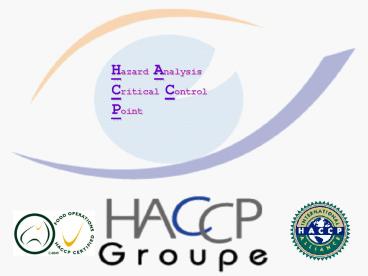Hazard Analysis Critical Control Point - PowerPoint PPT Presentation
1 / 49
Title:
Hazard Analysis Critical Control Point
Description:
Consumers of the Food. Develop a Flow Diagram Which. Describes the Process ... arenas where pathogenic organisms can enter the food chain' ----USDA/FSIS ... – PowerPoint PPT presentation
Number of Views:729
Avg rating:3.0/5.0
Title: Hazard Analysis Critical Control Point
1
Hazard Analysis Critical Control Point
2
HACCP A systematic approach to the
identification, evaluation, and control of food
safety hazards. Hazard Analysis The process of
collecting and evaluating information on hazards
associated with the food under consideration to
decide which are significant and must be
addressed in the HACCP plan.
Definitions
3
Definitions
Critical Control Point A step at which control
can be applied and is essential to prevent or
eliminate a food safety hazard or reduce it to an
acceptable level.
4
1959
gt
5
Method Development
- Sampling for Pathogenic microorganisms.
2. The Zero Defect Concept
3. Modes of Failure
6
1971
3 Principles
2. Determination of the critical control points
to control any identified hazards
- Identification and assessment of hazards
associated from growing to consumption
3.Establishmend of systems to monitor the
critical control points
7
1972
Outbreak of botulism!!!
Canned Potato Soup
Botulism
FDA promoted regulation of canned foods FDA
inspectors were trained for HACCP
8
1985
Report Microbiological Criteria for Foods and
Food Ingredients Approve HACCP
9
1988 4th volume HACCP in Food Safety and
Quality
1989 HACCP Principles for Food Production
--NACMCF
1991Guidelines for the Application of the
HACCP System
1992 Hazard Analysis and Critical
Control Point System-- NACMCF
10
Feb, 3 1995
There is wide agreement that ensuring food
safety requires taking steps throughout the
continuum of production, slaughter, processing,
distribution, and sale of livestock and poultry
carcasses and meat and poultry products to
prevent hazards and reduce the risk of foodborne
illness.
11
Developing a HACCP Plan
Preliminary Steps
12
Preliminary Steps
Developing a HACCP Plan
13
Preliminary Steps
Developing a HACCP Plan
14
Preliminary Steps
Developing a HACCP Plan
15
Preliminary Steps
Developing a HACCP Plan
16
Developing a HACCP Plan
Preliminary Steps
17
7 HACCP Prin ci ples
18
1.Conduct a hazard analysis Identify hazards
19
1.Conduct a hazard analysis Identify hazards
20
1.Conduct a hazard analysis Identify hazards
- 2.Determine the critical control points(CCP) in
the food preparation.
21
1.Conduct a hazard analysis Identify hazards
- 2.Determine the critical control points(CCP) in
the food preparation.
22
1.Conduct a hazard analysis Identify hazards
- 2.Determine the critical control points(CCP) in
the food preparation.
- 3.Establish critical limits for preventive
measures.
23
1.Conduct a hazard analysis Identify hazards
- 2.Determine the critical control points(CCP) in
the food preparation.
- 3.Establish critical limits for preventive
measures.
24
1.Conduct a hazard analysis Identify hazards
- 2.Determine the critical control points(CCP) in
the food preparation.
- 3.Establish critical limits for preventive
measures.
- 4.Establish procedures to monitor CCPs
25
1.Conduct a hazard analysis Identify hazards
- 2.Determine the critical control points(CCP) in
the food preparation.
- 3.Establish critical limits for preventive
measures.
- 4.Establish procedures to monitor CCPs
26
1.Conduct a hazard analysis Identify hazards
- 2.Determine the critical control points(CCP) in
the food preparation.
- 3.Establish critical limits for preventive
measures.
- 4.Establish procedures to monitor CCPs
27
(No Transcript)
28
- 5.Establish corrective action to be taken when
monitoring shows that a critical limit has been
exceeded.
29
- 5.Establish corrective action to be taken when
monitoring shows that a critical limit has been
exceeded.
30
6.Written HACCP Plan
- 5.Establish corrective action to be taken when
monitoring shows that a critical limit has been
exceeded.
31
6.Written HACCP Plan
- 5.Establish corrective action to be taken when
monitoring shows that a critical limit has been
exceeded.
32
7.Establish procedures to verify that the HACCP
plan is working.
6.Written HACCP Plan
- 5.Establish corrective action to be taken when
monitoring shows that a critical limit has been
exceeded.
33
7.Establish procedures to verify that the HACCP
plan is working.
6.Written HACCP Plan
- 5.Establish corrective action to be taken when
monitoring shows that a critical limit has been
exceeded.
34
1.Conduct a hazard analysis Identify hazards
7.Establish procedures to verify that the HACCP
plan is working.
- 2.Determine the critical control points(CCP) in
the food preparation.
6.Written HACCP Plan
- 3.Establish critical limits for preventive
measures.
- 5.Establish corrective action to be taken when
monitoring shows that a critical limit has been
exceeded.
- 4.Establish procedures to monitor CCPs
35
(No Transcript)
36
(No Transcript)
37
(No Transcript)
38
(No Transcript)
39
(No Transcript)
40
(No Transcript)
41
(No Transcript)
42
(No Transcript)
43
(No Transcript)
44
HCCP Application to Animal Production
- The voluntary application of HACCP principles
can be useful in establishing the CCPs within the
farm management and live animal transportation
arenas where pathogenic organisms can enter the
food chain ----USDA/FSIS
45
Biological Hazards
46
Samonella Free
????
Kronfagel
47
Assessment of HACCP systems
- Internal assessments/audits (the terms
assessment' and audit' are considered to be
equivalent here) carried out by those responsible
for the system independent - External assessments/audits skilled in the
process that is being undertaken, and able to
communicate effectively on any questionable
issue.
48
QUESTION??
49
Thank you For Your Attention!!!!
By
Ms.Viroonrat Chokchaithanakul ID 452-8202































